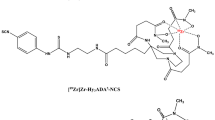Abstract
A 89Zr-oxine ex vivo cell labeling method for tracking various cells by positron emission tomography (PET) imaging has recently been developed. 89Zr-oxine is synthesized from oxine and 89Zr-chloride, which was converted from 89Zr-oxalate, with neutralization. To track migration of natural killer (NK) cells in vivo in real time by PET imaging, NK cells are labeled with 89Zr-oxine ex vivo and infused to a recipient. The labeling is performed by mixing 89Zr-oxine solution to NK cell suspension at room temperature, followed by washing. Care should be taken to label the cells at optimal radioactivity doses that maintain their viability and functionality. 89Zr-oxine labeled NK cells can be tracked for their migration and distribution by PET/computed tomography imaging for at least 7 days. Of note, this protocol is applicable to other types of cells.
Access this chapter
Tax calculation will be finalised at checkout
Purchases are for personal use only
Similar content being viewed by others
References
Ruggeri L, Aversa F, Martelli MF, Velardi A (2006) Allogeneic hematopoietic transplantation and natural killer cell recognition of missing self. Immunol Rev 214:202–218
Caligiuri MA (2008) Human natural killer cells. Blood 112:461–469
Vivier E, Raulet DH, Moretta A, Caligiuri MA, Zitvogel L, Lanier LL, Yokoyama WM, Ugolini S (2011) Innate or adaptive immunity? The example of natural killer cells. Science 331:44–49
Bern MD, Parikh BA, Yang L, Beckman DL, Poursine-Laurent J, Yokoyama WM (2019) Inducible down-regulation of MHC class I results in natural killer cell tolerance. J Exp Med 216:99–116
Bjorklund AT, Carlsten M, Sohlberg E, Liu LL, Clancy T, Karimi M, Cooley S, Miller JS, Klimkowska M, Schaffer M, Watz E, Wikstrom K, Blomberg P, Wahlin BE, Palma M, Hansson L, Ljungman P, Hellstrom-Lindberg E, Ljunggren HG, Malmberg KJ (2018) Complete remission with reduction of high-risk clones following haploidentical NK-cell therapy against MDS and AML. Clin Cancer Res 24:1834–1844
Rubnitz JE, Inaba H, Ribeiro RC, Pounds S, Rooney B, Bell T, Pui CH, Leung W (2010) NKAML: a pilot study to determine the safety and feasibility of haploidentical natural killer cell transplantation in childhood acute myeloid leukemia. J Clin Oncol 28:955–959
Geller MA, Cooley S, Judson PL, Ghebre R, Carson LF, Argenta PA, Jonson AL, Panoskaltsis-Mortari A, Curtsinger J, McKenna D, Dusenbery K, Bliss R, Downs LS, Miller JS (2011) A phase II study of allogeneic natural killer cell therapy to treat patients with recurrent ovarian and breast cancer. Cytotherapy 13:98–107
Martinez M, Moon EK (2019) CAR T cells for solid tumors: new strategies for finding, infiltrating, and surviving in the tumor microenvironment. Front Immunol 10:128
Vignali D, Kallikourdis M (2017) Improving homing in T cell therapy. Cytokine Growth Factor Rev 36:107–116
Hanahan D, Coussens LM (2012) Accessories to the crime: functions of cells recruited to the tumor microenvironment. Cancer Cell 21:309–322
Rahmim A, Zaidi H (2008) PET versus SPECT: strengths, limitations and challenges. Nucl Med Commun 29:193–207
Sato N, Wu H, Asiedu KO, Szajek LP, Griffiths GL, Choyke PL (2015) (89)Zr-oxine complex PET cell imaging in monitoring cell-based therapies. Radiology 275:490–500
Charoenphun P, Meszaros LK, Chuamsaamarkkee K, Sharif-Paghaleh E, Ballinger JR, Ferris TJ, Went MJ, Mullen GE, Blower PJ (2015) [(89)Zr]oxinate4 for long-term in vivo cell tracking by positron emission tomography. Eur J Nucl Med Mol Imaging 42:278–287
Asiedu KO, Koyasu S, Szajek LP, Choyke PL, Sato N (2017) Bone marrow cell trafficking analyzed by (89)Zr-oxine positron emission tomography in a murine transplantation model. Clin Cancer Res 23:2759–2768
Asiedu KO, Ferdousi M, Ton PT, Adler SS, Choyke PL, Sato N (2018) Bone marrow cell homing to sites of acute tibial fracture: (89)Zr-oxine cell labeling with positron emission tomographic imaging in a mouse model. EJNMMI Res 8:109
Hong SG, Sato N, Legrand F, Gadkari M, Makiya M, Stokes K, Howe KN, Yu SJ, Linde NS, Clevenger RR, Hunt T, Hu Z, Choyke PL, Dunbar CE, Klion AD, Franco LM (2020) Glucocorticoid-induced eosinopenia results from CXCR4-dependent bone marrow migration. Blood 136:2667–2678
Sato N, Stringaris K, Davidson-Moncada JK, Reger R, Adler SS, Dunbar C, Choyke PL, Childs RW (2020) In vivo tracking of adoptively transferred natural killer cells in rhesus macaques using (89)zirconium-oxine cell labeling and PET imaging. Clin Cancer Res 26:2573–2581
Man F, Lim L, Volpe A, Gabizon A, Shmeeda H, Draper B, Parente-Pereira AC, Maher J, Blower PJ, Fruhwirth GO, de Rosales RTM (2019) In vivo PET tracking of (89)Zr-labeled Vγ9Vδ2 T cells to mouse xenograft breast tumors activated with liposomal alendronate. Mol Ther 27:219–229
Weist MR, Starr R, Aguilar B, Chea J, Miles JK, Poku E, Gerdts E, Yang X, Priceman SJ, Forman SJ, Colcher D, Brown CE, Shively JE (2018) PET of adoptively transferred chimeric antigen receptor T cells with (89)Zr-oxine. J Nucl Med 59:1531–1537
Kurebayashi Y, Choyke PL, Sato N (2021) Imaging of cell-based therapy using (89)Zr-oxine ex vivo cell labeling for positron emission tomography. Nanotheranostics 5:27–35
Author information
Authors and Affiliations
Corresponding author
Editor information
Editors and Affiliations
Rights and permissions
Copyright information
© 2022 The Author(s), under exclusive license to Springer Science+Business Media, LLC, part of Springer Nature
About this protocol
Cite this protocol
Sato, N., Szajek, L.P., Choyke, P.L. (2022). Tracking of NK Cells by Positron Emission Tomography Using 89Zr-Oxine Ex Vivo Cell Labeling. In: Shimasaki, N. (eds) Natural Killer (NK) Cells. Methods in Molecular Biology, vol 2463. Humana, New York, NY. https://doi.org/10.1007/978-1-0716-2160-8_11
Download citation
DOI: https://doi.org/10.1007/978-1-0716-2160-8_11
Published:
Publisher Name: Humana, New York, NY
Print ISBN: 978-1-0716-2159-2
Online ISBN: 978-1-0716-2160-8
eBook Packages: Springer Protocols




